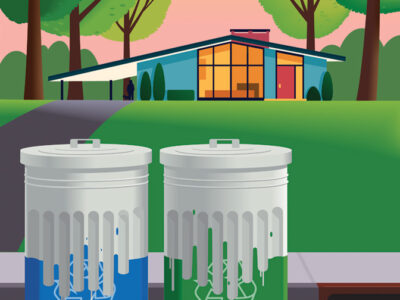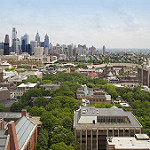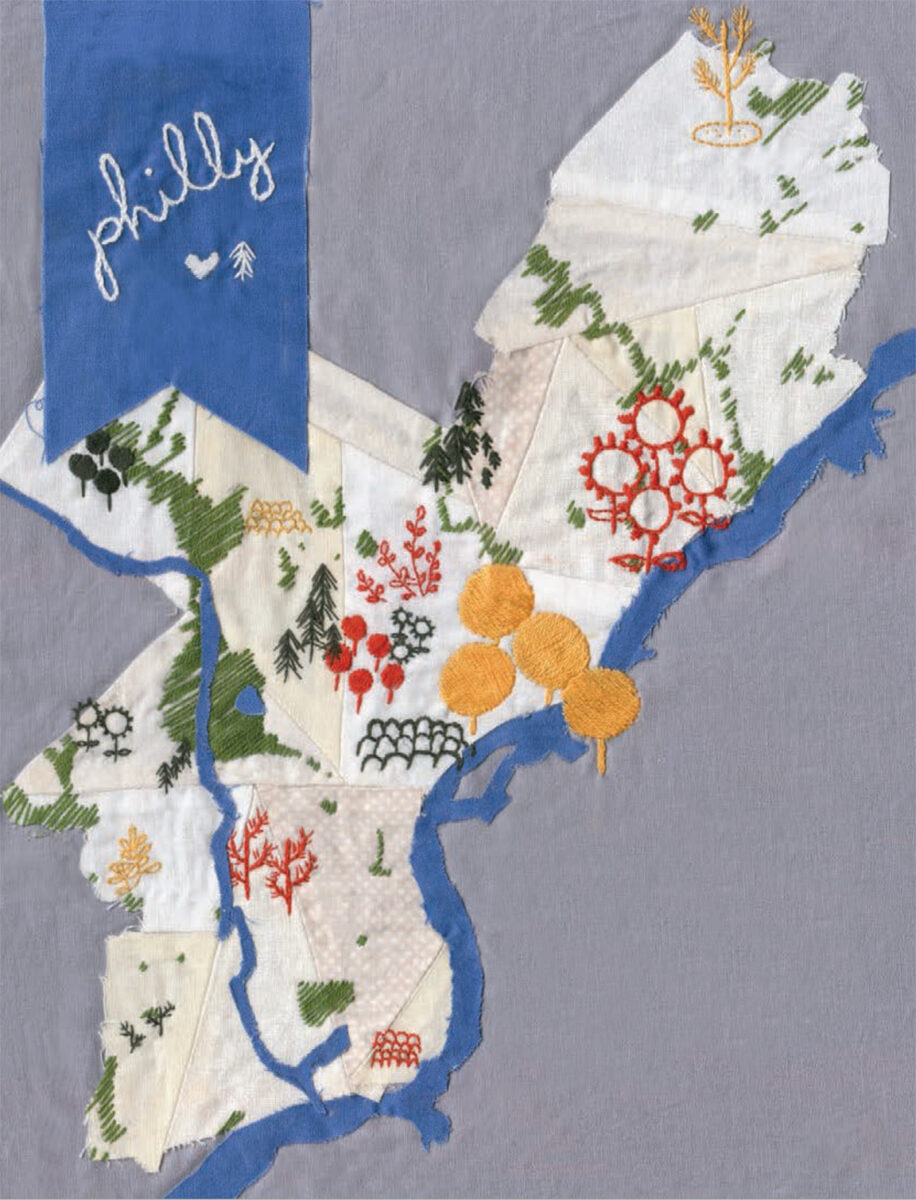
Penn Praxis has a plan for adding 500 acres of open green space to Philadelphia in the next four years. Their approach, informed by novel research by Penn scholars in areas ranging from real-estate economics to criminology, is a new way of imagining urban parkland.
By Trey Popp
Illustration by Caroline Hwang
There are plenty of reasons to like city parks. They give joggers a place to run, seniors a place to walk, kids a place to cartwheel into their elders’ paths. For downtown dog owners and penned-up parents, a nearby patch of grass may be the difference between a lasting interior paint job and claw marks on the walls. For a townhouse dweller making do with a hundred square feet of sun-blasted roof deck, the shade of a sugar maple might be enough to make August a month worth living.
Penn Praxis, the student-faculty clinical consulting practice in the School of Design, makes the case for parkland in rather stronger terms. In a recent report outlining a rationale for creating 500 acres of new public green space in Philadelphia over the next four years, the group credits urban greening projects with providing a seemingly miraculous range of benefits.
For starters, there’s cold, hard cash. Converting vacant properties into tidy lawns or community gardens, the report argues, can raise local property values, swell city tax revenues, and save the fire and police departments literally millions of dollars a year in averted emergency-call responses. Replacing impervious asphalt with rain-absorbing green space has already saved the city water department $35 million in hard infrastructure costs since 2006—gains that could be multiplied. The same goes for the output of community gardens, which produced an estimated 2 million pounds of fresh produce in Philadelphia in the summer of 2008 alone, valued at almost $5 million.
Then there are benefits that are harder to quantify directly, but may yield even bigger returns. Turning abandoned buildings into park-like amenities reduces crime, the Penn Praxis report claims. Adding 500 acres of green space could help prevent 20 asthma attacks a year as a result of improved air quality. The authors also cite a 2010 study that credited Philadelphia’s existing open space with generating health-related cost savings in excess of $400 million.
“Simply put,” the Penn Praxis plan declares, “city parks save lives.”
That is a lofty claim, and so are many of the others. But the declarations in Green 2015: An Action Plan for the First 500 Acres—commissioned by Philadelphia’s Department of Parks and Recreation and backed by the administration of Mayor Michael Nutter W’79—are based in no small part on evidence being developed by an eclectic constellation of Penn scholars. The analysis of urban open spaces, once the exclusive preserve of landscape architects and city planners, has been taken up by real-estate economists, criminologists, and experts in public health. Here is a survey of some of their research, and how it may inform a new take on city parkland in Philadelphia.
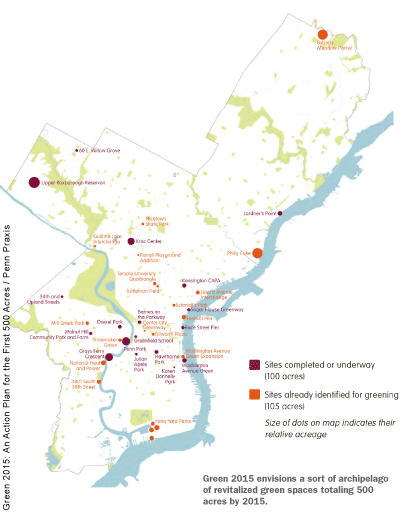
The most noticeable aspect of Penn Praxis’s Green 2015 plan is that, to a substantial degree, the new green spaces it envisions are not very noticeable at all. On a map of the whole city, they barely show up—certainly not the way Fairmount Park does, or the 843 acres of Central Park do on a map of New York. Instead, the plan envisions a sort of archipelago of revitalized green spaces—mixing public and private development—that range in size from the 24-acre Penn Park down to parcels as modest as the new one-third-acre Julian Abele Park in southwest Center City [“Window,” Jan|Feb 2011], or even as small as single vacant lots.
“In an era of constrained times,” says Penn Praxis director Harris Steinberg C’78 GAr’82, “and difficult political tensions between [City] Council and the [mayoral] administration … we really wanted to make this as easily digestible as possible.” Accordingly, they laid out a plan they feel is capable of having a “transformative impact, but on a series of small scales”—rather than the sort of grand vision a latter-day Robert Moses or Frederick Law Olmsted might dream up.
The crux of the plan is to draw from an asset that Philadelphia has in abundance: vacant and abandoned land. The report observes that Philadelphia contains more than 4,000 acres of vacant lots and abandoned buildings. About one-quarter of that total belongs to the city.
“The city is paying $21 million a year to manage all of that, regardless of ownership,” says Steinberg, noting that it costs money to seal off condemned buildings, respond to arson, and fight crime in row homes that have been abandoned to drug dealers. “And if you can start to redirect some of that to actually productive landscapes that can help increase property values,” he adds, “you shift the whole paradigm.”
As anyone who lives across the street from Central Park can tell you, the idea that open green space can enhance property values isn’t exactly novel. Nor is this the first time Philadelphia has tried to clean up derelict properties; former Mayor John Street’s Neighborhood Transformation Initiative tried with mixed success to do just that in some parts of the city in the first few years of the last decade [“Gazetteer,” Sept|Oct 2010]. But until recently, the notion that public greening could “shift the whole paradigm” of urban decrepitude was supported more by intuition than evidence—at least when it comes to measuring the effects of brand new parks, particularly those built on a much more modest scale. In the last several years, Wharton’s Susan Wachter has gone a long way to filling in that gap.
Wachter, who is the Richard B. Worley Professor of Financial Management and a specialist in real-estate economics, has been asking questions like, How much does cleaning up a vacant lot increase the market value of the house next door? and How much is a sidewalk tree worth? Tapping into the expertise of Wharton’s GIS (Geographic Information Systems) Lab and culling data from the city tax board and the Pennsylvania Horticultural Society (PHS), Wachter and her colleagues have come up with some compelling answers.
In a 2005 paper, she investigated the effects of a pilot program in which the New Kensington Community Development Corporation teamed up with PHS to implement a greening strategy in that depressed section of Philadelphia [“Gazetteer,” July|Aug 2005]. The program focused on replacing abandoned lots with tree-ringed landscapes of mowed grass, as well as planting sidewalk trees.
GIS software enabled Wachter to measure the precise distance of every home from a stabilized lot or tree planting. Coupled with sales data from 1980 to 2003, this permitted her to draw some striking conclusions about the impact of the greening pilot program (which had cleaned the trash from 18,800 lots between 2000 and 2003, and improved about 12,000 of them). “Vacant land improvements result in surrounding housing values increasing by as much as 30 percent,” she wrote. “New tree plantings increase surrounding housing values by approximately 10 percent. In the New Kensington area this translates into a $4 million gain in value through tree plantings and a $12 million gain through lot improvements.”
In that light, it seems fitting that her employer recently partnered with the city Department of Parks and Recreation to give away 300 free trees to faculty and staff living within city limits in a pilot program called “Creating Canopy with Penn.” Another new University initiative, more symbolic in nature but a sign of the zeitgeist nonetheless, is the planting of a different tree species every year—one specimen on campus and a second designated at the Morris Arboretum—to honor the graduating class. The Class of 2011 was commemorated with a sugar maple in April.
In a 2008 paper with assistant professor of real estate Grace Wong Bucchianeri, Wachter argued that the property-value increase associated with tree plantings is largely attributable to “either social capital creation or a signaling mechanism.” In other words, tree plantings send a signal to prospective home buyers that the community is becoming more actively involved in improving the neighborhood. About a quarter of the increase, they contended, stemmed from the intrinsic value of the tree.
This underscores a related point, which is that the payoff of public investment in greening depends on where it’s carried out. ““It’s not just greening of the space that does it—it’s the fact that you’ve greened a space that previously was depressing property values,” says Kevin Gillen GrW’05, a research colleague of Wachter’s. (Wachter is currently on leave.)
“If you go out to Lower Merion and demolish someone’s home and convert it into a little park, will that increase the value of the home next door?” he asks rhetorically. “Yes? By that much? No. Because what was there before was pretty nice. But if you’ve got a blighted abandoned factory in Kensington, which is just all asphalt and soil that has chemicals in it, and rusty hulking buildings, and you convert that to a park, you have much bigger spillover effect on the nearby home values.”
Gillen, who has pressed this research forward as a vice president of Econsult, a Philadelphia-based economic consulting firm, says that the best areas a city can target for greening are “neighborhoods on the margins.”
“That is, they’re not completely distressed, abandoned neighborhoods. But they’re neighborhoods that are sort of at the tipping point of turning around,” he explains. “Where they do the least good are the neighborhoods that would be considered the most depressed in the city. They have the highest crime, the highest abandonment. Those neighborhoods need more help than just putting in a community garden. They need better policing, fire, trash collection. They need a lot more help than just converting a vacant lot. But in marginal neighborhoods, replacing an abandoned home with a community garden signals to the neighbors that, hey, maybe something is happening here, it’s turning around, you’ve got another amenity.”
The Penn Praxis report observes that even with Fairmount Park, the largest city-owned park system in the world, Philadelphia still has a need for more green spaces. “There are currently more than 200,000 Philadelphians, about 1 in 8 residents, who do not live within a 10-minute walk of a public green space,” the report notes. “Leaving this many citizens without access to park space is like leaving the entire cities of Allentown and Erie combined without access to parks.”
Among the variables that influence a house’s value—from the number of bedrooms and bathrooms to the number of garage bays (Wachter took 50 such variables into account in her New Kensington study)—“in general we find that public amenities are somewhere in the middle,” Gillen says.
“Any new kitchen can increase the value of your home a lot,” he adds. “[But] if you’re right next to an abandoned home being used for criminal activity, and the next day it’s a community garden, you can expect the effect to be pretty large. It’s not just that you have a community garden. It’s that the crime is gone, you’ve got a better view out your kitchen window, the air is cleaner, you’ve got a potential source for food.”
And unlike a lot of kitchen makeovers, the cost-benefit ratio of turning a vacant lot (or a cluster of them) into a pocket park can be very favorable.
“Measured bang for buck, it’s quite positive,” says Gillen. “Because in general what we often found is that the value created would often exceed the cost of doing it. If it costs you $10,000 to green a lot but it creates $15,000 in additional property value, then that’s a gain to taxpayers.”
The Penn Praxis report cites a study by Gillen and Todd Baylson GCP’04 which found that homes near newly converted green spaces appreciated in value at an average rate of 13.3 percent per year during a period when the average home value appreciated at a 7.8 percent annual rate. Over a seven-year period, this translated into a $22.2 million gain in incremental property-tax revenue.
Gillen is quick to emphasize that greening is not the end-all of urban invigoration.
“There’s a reason that we’re looking at this issue” in Philadelphia, he says. “And it’s because we’re not a growing city … These 40,000 vacant parcels represent dead assets on the city’s balance sheet. If something can be done with them, [the priority] should be to add to the tax base” via residential or commercial development.
“Of course the reason Philadelphia has so many vacant parcels and abandoned buildings, unlike, say San Francisco, is because we’ve basically been a depopulating and contracting city,” he adds. “On top of that, our construction costs are among the highest in the country, despite the fact that our home prices are among the lowest of large cities. So there’s economic incentive to systematically under-invest in maintaining or developing real estate.
“Insofar as the city is willing to take those steps to really turn it around and make it a competitive city, it’s going to have this problem with vacant and abandoned parcels. So the question becomes: What’s the next best thing you can do with them? And in that case, since you can’t develop them at market rate and do so profitably, then you may as well use some public moneys to convert them to some other use, to eliminate blight and enhance your tax base by improving local property values in the neighborhood.”
Penn Praxis’s Steinberg echoes that sentiment. “I think that really helps shape the economic argument for transforming vacant land,” he says. “Now that doesn’t mean it all has to be green space. We want people to move into the city, we want the tax base to rise, we want the school system to get better … All those things are important. But we have found that there is a direct impact between quality green space and property values, social cohesion, and then we get into public health and then all those other reasons.”
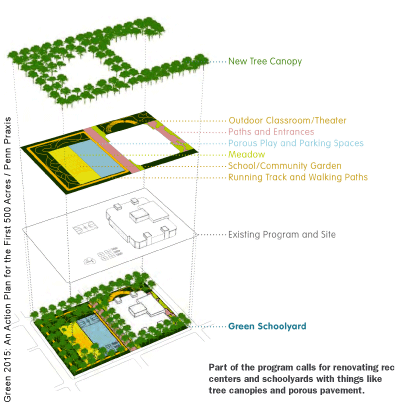
Public health and “all those other reasons” have a burgeoning champion in the person of Charles Branas, an associate professor of epidemiology as well as emergency medicine at the Raymond and Ruth Perelman School of Medicine, whose academic portfolio ranges from cartographic modeling to criminology research.
“There’s been so little done with greening and open green space and its impact,” Branas says. “People have been debating it for decades, but there’s been very little actual empirical work done on this … We’re following on some of Susan [Wachter]’s work and expanding on more than just the economic impact for specific property owners. We’re really thinking about the neighborhoods and the health and safety impacts.”
Branas and several colleagues have come at it from several angles, one of which involves ecological studies—population-scale analyses of phenomena like the impact of smoking on lung cancer rates. While considered less robust than cohort or case-control studies, ecological studies can produce insights that help epidemiologists model the effects of certain behaviors or interventions on things like neighborhood crime levels. That’s how vacant land rose to Branas’ attention.
“What was striking about these models [that came out of our study] is that, in the laundry list of different things that could have affected crime—economic conditions, poverty, racial conditions, segregation, all these things—vacant properties rose to the top as the strongest effect in terms of correlating with crime. And so that was really telling. I was very surprised by it.”
This line of inquiry is still in progress, but it has yielded some more specific observations.
“What we’re finding in this is that there are certain crimes that seem to have been highly affected by the greening,” Branas says. “For instance, we think gun assault is something that’s been highly affected. And maybe gun robbery at some level.
“We think that’s the case because there’s been some early anthropologic ethnographic work in places like New Haven and Detroit where they will follow criminals with illegal firearms. And most of them don’t carry their weapons with them. This is one theory, right. Most of them don’t carry their weapons with them because it’s illegal to have them. You have other arrests, you’re a felon: you’re not going to carry your weapon, but you need it because you’re part of this illegal drug trade, let’s say, for instance. You need that protection. So they will often, apparently, store the weapons on vacant lots.”
Branas is currently planning to embark on an experiment in which a large group of vacant lots will be randomly selected to be greened, and the subsequent public-health and crime impact compared to another randomly selected group of similar lots that were not greened. He also hopes to install time-lapse cameras in some vacant lots to gather finer-grained observations.
“In our fieldwork, going and visiting the lots,” he explains, “at the middle of the day, you will see a goat path beat into the middle of the lot if it’s very overgrown. There are a lot of places to hide. Clearly people are entering and going through them and using them in some capacity. But it’s unclear how much and for what. And it would be really neat to observe this firsthand, if possible, before and after a greening intervention. So what happens? What’s the foot traffic like when the lot’s overgrown and trash strewn, versus after you green it? Does it really change? I don’t know. Maybe it doesn’t.”
Depending on the results, Branas points out, greening could turn out to be an unusually cost-effective crime-reduction mechanism.
“Public health has really, over the past 40 years or so, concentrated more on dealing with individuals and a biomedical model or a bio-behavioral model, where you’re really seeking to either treat people medically and try to get them more treatment, or you’re seeking to treat them one by one as individuals and try to change their behavior with some psychological campaign,” he observes. “Those are wonderful. In fact, many of them have been shown to be incredibly successful. The problem is, scaling it up isn’t so easy and is immensely costly. Millions of dollars to treat a handful of high-risk kids in one neighborhood is wonderful, because those kids do reap the benefit of that. But it’s not sustainable because you can’t keep spending millions of dollars year after year for a handful of kids.
“So in thinking about greening,” he goes on, “it’s sort of a long shot—or it was. But if it works, it’s incredibly inexpensive, relative to an army of psychologists or public health workers going into the neighborhood. And everyone may get the benefit of the greening: people who are high-risk and coming through the area, and people who live there and so forth whether they’re high-risk or not.”
Like much of the research it draws from, the Green 2015 plan focuses broadly on green space without delving too deeply into the finer details of what specific functions it should serve. Community gardening and urban agriculture surface here and there, but in such general terms that they essentially come off as placeholders awaiting a more comprehensive treatment. They have a strong advocate in another member of Penn’s faculty, though.
Domenic Vitiello, an assistant professor of city and regional planning in the School of Design, has spent the last several summers investigating, with urban-studies lecturer Michael Nairn, Philadelphia and Camden’s community gardens in an up-close and personal way. (It becomes clear that there’s no other way to put it when he wakes up his desktop monitor to reveal a wallpaper photo of the Camden Men’s Garden, and says, “That’s where Michael and I want to retire.”)
“It’s very well established,” says Vitiello, that community gardens “are very effective tools for stabilizing neighborhoods, helping them be safer, more attractive, helping to encourage people to pick up trash more and invest in them … But its economic returns are very indirect. And that’s one of the reasons we went around and tried to count, and put some dollar signs on the produce of community gardens.”
The Penn Praxis plan mentions one of their findings: that community and squatter gardens yielded an estimated 2 million pounds of food, valued at almost $5 million, in a single summer. For Vitiello, though, the dollar signs don’t tell the whole story. Gardeners don’t just produce a lot of food; they give a lot away. Sometimes nearly everything they grow, whether to neighbors or food banks. They also get exercise (a big benefit, since so many gardeners tend to be older), help nourish cultural traditions (by growing hard-to-buy crops like pigeon peas and creole corn), and in many cases provide opportunities for kids on summer break to help with something productive.
So for Vitiello, the strongest case for urban agriculture isn’t really the economic one. “The impacts go well beyond food. They’re mostly social impacts,” he says.
“The whole conversation about why we garden and why we need urban agriculture changed when Susan Wachter did her studies of greening—which were not very much about urban agriculture—in the Fishtown area,” he says. “Then some scholars at NYU knocked off Susan’s methodology, but just for community gardens in New York, and found some really interesting things: that they raise adjacent property values. And it’s maybe unfair to say that’s all certain policymakers in Philadelphia care about, but for the most part, that’s what they care about.”
He worries that this perspective has pushed policymakers’ views about community gardening in the wrong direction.
“[Some people have the idea] that urban farming could be a really wonderful interim use for land that the RDA [Philadelphia Redevelopment Authority] holds, as a way to improve properties and sell them in three to five years,” he says. “That’s a great idea for the RDA. But I don’t know any farmer or gardener in Philadelphia, or any other city, who would really want that. Because what farmers and gardeners build is not really visible—it’s soil, and relationships with one another and their neighbors.”
For that reason, he hopes Philadelphia will think again about policies like the city’s new lease agreement for gardeners on public land, which would require gardeners to carry insurance on those currently vacant lots at the level of fully developed properties.
The capacity of community gardens to raise property values and therefore the tax base is all well and good, he hastens to add. But that shouldn’t be the only goal, or even the ultimate one. “Urban agriculture—farming and gardening—is great social policy,” Vitiello says. “It’s great public health policy. It’s good environmental policy. It’s the sort of thing that gets regular residents—as opposed to city departments spending tax dollars—to invest in cleaning up cities and make them more wonderful in many ways. So it’s a very efficient sort of investment.”
Like all of these sorts of plans, Green 2015 is more a vision than a shovel-ready project, as they say. But there are signs that it’s gaining traction. Since the beginning of the Nutter administration, 100 acres have already been greened or are under way. Another 105 have been identified for future work. The Penn Praxis report is chock full of GIS maps designed to shed light on where new parks might provide the most bang for the buck—highlighting areas where residents are under-served, where heat-related fatalities are highest, where tree canopies are insufficient, and so on.
Meanwhile, the city’s Department of Licenses and Inspections (L&I) has begun a pilot project to ramp up enforcement on 143 properties in the Northeast, taking a harder line on property owners who fail to bring their derelict properties up to code. Other sections of the city have also seen an uptick in the ticketing of derelict buildings by L&I, sometimes instructing owners to either rehab or demolish them. Perhaps that will be a first step toward reclaiming Philadelphia’s vacant and abandoned land for something better and greener.
“I believe that it’s a way out of the post-industrial landscape that we have—the literal landscape, which is blighted in many places, inequitable in many places,” says Harris Steinberg of the Green 2015plan.
“These small doses—in this case of green—I think can have a big effect in the aggregate,” he adds. “Perhaps as much as the creation of Fairmount Park initially did. I wouldn’t go so far as to say that ultimately it’s going to have that kind of sweeping effect, but in the end, when we’ve pieced together this kind of network of trails and greenways and access routes, we can really begin to think: Can we take these little archipelagos of parks, and really make them into one big system?”
A question, perhaps, to be posed when 2020 appears on the horizon.



